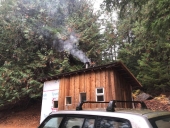Michael Gillingham wrote:Erik,in your last paragraph you talked about heat transfer with pebbles being better than sand.That will actually be to my benefit because when I break up the block there will be pieces from pebble to golf ball and larger.I thought that any air space would act as an insulator.This build is in my garage and it only needs to keep the temps hopefully above 40.The block pieces will be contained in a block box which will be about 18" high 15 ft wide and 32" deep.That will allow me to test it with only block fill and see how it goes.Thanks again.
Air is a great insulator. Unless it moves. Then it carries heat, and is the opposite of in insulating material/medium.
The idea is that sand inhibits the air movement to such a degree that it acts as an insulator; because the air cannot move or escape (which would carry away the heat as it did so). Pebbles, being larger, allow more air movement. You may have seen beds of gravel used as thermal storage in passive solar systems?: Larger pieces of stone make for larger air gaps, and the larger the air gap, the less it behaves as an insulator and the more it carries heat to wherever it can (heat moves toward cold, not the other way around).
Thus, in the consideration of stone materials and air gaps (sand, pebbles, gravel, broken rock rubble, etc) it is not the elements (air or stone - understanding sand, gravel, and rock are all being called "stone" in this illustration) that are critical, but rather their relationship to one another.
The bottom line is: Can the air can move freely, and if so, to what degree.
If the air doesn't move at all, it is a really very good insulator. This is why materials that create and capture tiny air pockets work so well as insulators (extruded foam, perlite, rock wool, and on and on - if the temps are low enough those plastic blankets of air bubbles make really good insulators - I use them when allowing my home made soap to set up all the time (I am NOT suggesting they be used in any part of a RMH build, it is way, way too hot, even in the thermal mass bench for that to be sensible)).
If the air flows without being slowed down at all, it carries heat very effectively. This is why a 1-inch air gap behind a metal shielding material works so well as a heat shield around fire places and wood burning stoves, for example. This is one way we may protect our walls and ceiling from catching fire.
Now, to your point....
In your thermal mass, you really do *not* want to have insulators. Around the super hot fire box, yes. So in the RMH designs, in one area we strive for excellent insulation effect, and in another area, we strive for as little insulation as possible. (And one could argue the manifold is a transition point between way super hot air that we want to keep hot as possible, and the bench and exhaust where we are trying to suck most of the heat out of the exhaust, and get it to move into our thermal mass, and later into our living space. If one makes this argument -which is sensible- we have three types/regions of thermal areas in our RHM.)
So pack the fire box (those parts built with fire brick or other refractory materials, and where the fire is produced, or the gases are to be burned: the feed tube, burn chamber, and fire riser) with as much insulation, and as good of insulation as you can obtain/afford.
In the bench you want the opposite effect. The bench conducts heat nicely, when it is made out of solid stone or clay, etc. The reason it doesn't get burning hot is there is so much of it, and it takes so long for the heat to move into and through the material (about 1" per hour for average cob, is the rule of thumb). So the cob/stone/clay/brick bench does not get *hot* but it is not an insulator either.
Same thing with a fire brick. It is *not* an insulator. Heat does take a good while to move through it, but that is not the same thing as being an insulating material; fire brick has high aluminum content and is a conductive material. It is just pretty dense, and it takes a while for the heat to move through it. But the bigger point, for fire brick, is that it has a lot of metal in it and is able to take a lot of thermal shock without falling apart, rapid expansion and contraction.
Therefore...
Air pockets in your thermal mass are not ideal. But they can work, if properly scaled to the other parts of the system (once again, refer to passive solar thermal storage using gravel beds, or even weaving mazes of concrete block used to form pathways).
I would not take any of this to imply that broken rubble fill, with air gaps, will work better than the same rubble fill packed in place with clay. The clay-packed-rubble will work a lot, lot better, and exactly because the clay replaces the air pockets, and encourages conductive heat transfer throughout the thermal bench.
So if you use broken rubble without the clay, do so knowing it is a compromise solution. And do not use sand; use pebbles, gravel, or broken rubble.
I suspect you get this point, but I am also trying to be super clear for the benefit of anyone new to the ideas that may happen to read this in the future.










































 1
1













